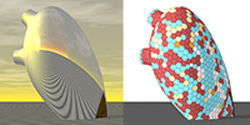

Abstract:
Paneling an architectural freeform surface refers to an approximation of the design surface by a set of panels that can be manufactured using a selected technology at a reasonable cost, while respecting the design intent and achieving the desired aesthetic quality of panel layout and surface smoothness. Eigensatz and co-workershave recently introduced a computational solution to the paneling problem that allows handling large-scale freeform surfaces involving complex arrangements of thousands of panels. We extend this paneling algorithm to facilitate effective design exploration, in particular for local control of tolerance margins and the handling of sharp crease lines. We focus on the practical aspects relevant for the realization of large-scale freeform designs and evaluate the performance of the paneling algorithm with a number of case studies.
Bibtex:
@incollection{aag201049,
author={Michael Eigensatz and Mario Deuss and Alexander Schiftner
and Martin Kilian and Niloy J. Mitra and Helmut Pottmann
and Mark Pauly},
title={Case Studies in Cost-Optimized Paneling of Architectural
Freeform Surfaces},
pages={49-72},
booktitle={Advances in Architectural Geometry 2010},
editor={Cristiano Ceccato and others},
publisher={Springer},
year={2010},
}